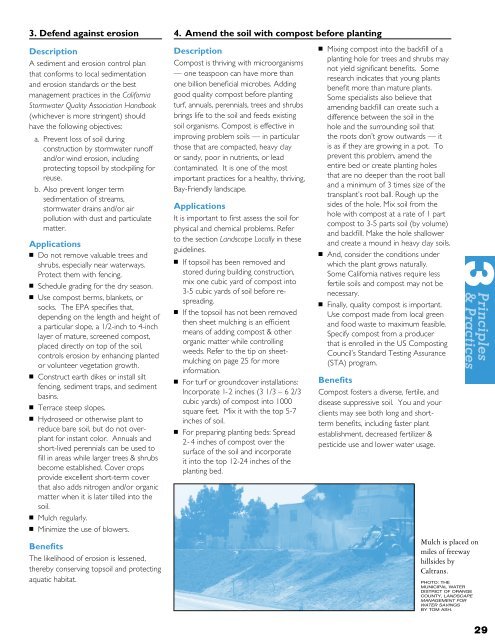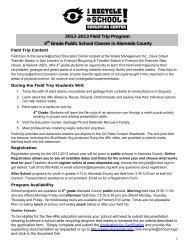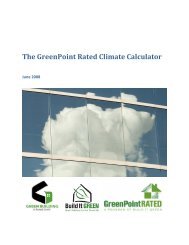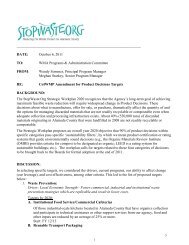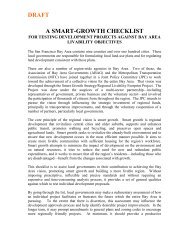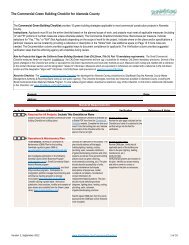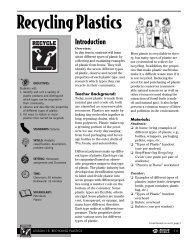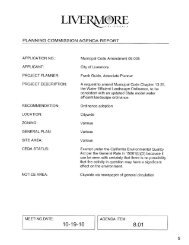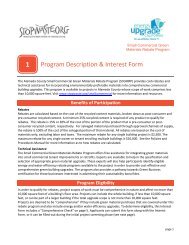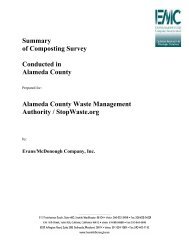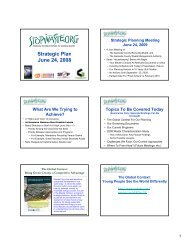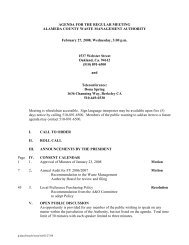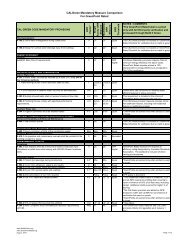Bay-Friendly Landscaping Principles and Practices - StopWaste.org
Bay-Friendly Landscaping Principles and Practices - StopWaste.org
Bay-Friendly Landscaping Principles and Practices - StopWaste.org
Create successful ePaper yourself
Turn your PDF publications into a flip-book with our unique Google optimized e-Paper software.
3. Defend against erosion<br />
Description<br />
A sediment <strong>and</strong> erosion control plan<br />
that conforms to local sedimentation<br />
<strong>and</strong> erosion st<strong>and</strong>ards or the best<br />
management practices in the California<br />
Stormwater Quality Association H<strong>and</strong>book<br />
(whichever is more stringent) should<br />
have the following objectives:<br />
a. Prevent loss of soil during<br />
construction by stormwater runoff<br />
<strong>and</strong>/or wind erosion, including<br />
protecting topsoil by stockpiling for<br />
reuse.<br />
b. Also prevent longer term<br />
sedimentation of streams,<br />
stormwater drains <strong>and</strong>/or air<br />
pollution with dust <strong>and</strong> particulate<br />
matter.<br />
Applications<br />
n Do not remove valuable trees <strong>and</strong><br />
shrubs, especially near waterways.<br />
Protect them with fencing.<br />
n Schedule grading for the dry season.<br />
n Use compost berms, blankets, or<br />
socks. The EPA specifies that,<br />
depending on the length <strong>and</strong> height of<br />
a particular slope, a 1/2-inch to 4-inch<br />
layer of mature, screened compost,<br />
placed directly on top of the soil,<br />
controls erosion by enhancing planted<br />
or volunteer vegetation growth.<br />
n Construct earth dikes or install silt<br />
fencing, sediment traps, <strong>and</strong> sediment<br />
basins.<br />
n Terrace steep slopes.<br />
n Hydroseed or otherwise plant to<br />
reduce bare soil, but do not overplant<br />
for instant color. Annuals <strong>and</strong><br />
short-lived perennials can be used to<br />
fill in areas while larger trees & shrubs<br />
become established. Cover crops<br />
provide excellent short-term cover<br />
that also adds nitrogen <strong>and</strong>/or <strong>org</strong>anic<br />
matter when it is later tilled into the<br />
soil.<br />
n Mulch regularly.<br />
n Minimize the use of blowers.<br />
Benefits<br />
The likelihood of erosion is lessened,<br />
thereby conserving topsoil <strong>and</strong> protecting<br />
aquatic habitat.<br />
4. Amend the soil with compost before planting<br />
Description<br />
Compost is thriving with micro<strong>org</strong>anisms<br />
— one teaspoon can have more than<br />
one billion beneficial microbes. Adding<br />
good quality compost before planting<br />
turf, annuals, perennials, trees <strong>and</strong> shrubs<br />
brings life to the soil <strong>and</strong> feeds existing<br />
soil <strong>org</strong>anisms. Compost is effective in<br />
improving problem soils — in particular<br />
those that are compacted, heavy clay<br />
or s<strong>and</strong>y, poor in nutrients, or lead<br />
contaminated. It is one of the most<br />
important practices for a healthy, thriving,<br />
<strong>Bay</strong>-<strong>Friendly</strong> l<strong>and</strong>scape.<br />
Applications<br />
It is important to first assess the soil for<br />
physical <strong>and</strong> chemical problems. Refer<br />
to the section L<strong>and</strong>scape Locally in these<br />
guidelines.<br />
n If topsoil has been removed <strong>and</strong><br />
stored during building construction,<br />
mix one cubic yard of compost into<br />
3-5 cubic yards of soil before respreading.<br />
n If the topsoil has not been removed<br />
then sheet mulching is an efficient<br />
means of adding compost & other<br />
<strong>org</strong>anic matter while controlling<br />
weeds. Refer to the tip on sheetmulching<br />
on page 25 for more<br />
information.<br />
n For turf or groundcover installations:<br />
Incorporate 1-2 inches (3 1/3 – 6 2/3<br />
cubic yards) of compost into 1000<br />
square feet. Mix it with the top 5-7<br />
inches of soil.<br />
n For preparing planting beds: Spread<br />
2- 4 inches of compost over the<br />
surface of the soil <strong>and</strong> incorporate<br />
it into the top 12-24 inches of the<br />
planting bed.<br />
n Mixing compost into the backfill of a<br />
planting hole for trees <strong>and</strong> shrubs may<br />
not yield significant benefits. Some<br />
research indicates that young plants<br />
benefit more than mature plants.<br />
Some specialists also believe that<br />
amending backfill can create such a<br />
difference between the soil in the<br />
hole <strong>and</strong> the surrounding soil that<br />
the roots don’t grow outwards — it<br />
is as if they are growing in a pot. To<br />
prevent this problem, amend the<br />
entire bed or create planting holes<br />
that are no deeper than the root ball<br />
<strong>and</strong> a minimum of 3 times size of the<br />
transplant’s root ball. Rough up the<br />
sides of the hole. Mix soil from the<br />
hole with compost at a rate of 1 part<br />
compost to 3-5 parts soil (by volume)<br />
<strong>and</strong> backfill. Make the hole shallower<br />
<strong>and</strong> create a mound in heavy clay soils.<br />
n And, consider the conditions under<br />
which the plant grows naturally.<br />
Some California natives require less<br />
fertile soils <strong>and</strong> compost may not be<br />
necessary.<br />
n Finally, quality compost is important.<br />
Use compost made from local green<br />
<strong>and</strong> food waste to maximum feasible.<br />
Specify compost from a producer<br />
that is enrolled in the US Composting<br />
Council’s St<strong>and</strong>ard Testing Assurance<br />
(STA) program.<br />
Benefits<br />
Compost fosters a diverse, fertile, <strong>and</strong><br />
disease suppressive soil. You <strong>and</strong> your<br />
clients may see both long <strong>and</strong> shortterm<br />
benefits, including faster plant<br />
establishment, decreased fertilizer &<br />
pesticide use <strong>and</strong> lower water usage.<br />
Mulch is placed on<br />
miles of freeway<br />
hillsides by<br />
Caltrans.<br />
Photo: the<br />
Municipal Water<br />
District of Orange<br />
County, L<strong>and</strong>scape<br />
Management for<br />
Water Savings<br />
by Tom Ash.<br />
3 <strong>Principles</strong><br />
& <strong>Practices</strong><br />
29


